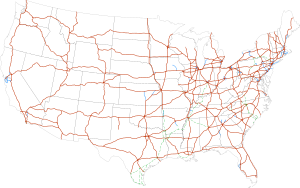| Dwight D. Eisenhower National System of Interstate and Defense Highways | |
|---|---|
Highway shields for Business Loop Interstate 24 and Business Spur Interstate 196 | |
 Interstate Highways in the 48 contiguous states | |
| System information | |
| Formed | June 29, 1956[1] |
| Highway names | |
| Interstates | Interstate nn (I-nn) |
| Business Loop: | Business Loop Interstate nn (BL I-nn) Interstate nn Business Loop (I-nn Bus. or I-nn BL) |
| Business Spur: | Business Spur Interstate nn (BS I-nn) Interstate nn Business Spur (I-nn Bus. or I-nn BS) |
| System links | |
The Interstate Highway System of the United States, in addition to being a network of freeways, also includes a number of Business Routes assigned by the American Association of State Highway and Transportation Officials (AASHTO). These routes connect a central or commercial district of a city or town with an Interstate bypass, and are signed with green shields resembling the Interstate Highway shield. The word BUSINESS is used instead of INTERSTATE, and, above the number, where the state name is sometimes included, the word LOOP or SPUR appears. A business loop has both ends as its "parent", while a business spur has a "dangling end", sometimes running from the end of the Interstate to the downtown area.
As the main purpose of these routes are to serve a certain downtown area, Business Interstates are typically routed along surface roads. These routes do not have to meet Interstate Highway standards and are not considered part of the Interstate Highway System. AASHTO does, however, apply similar standards as to new U.S. Highways, requiring a new Business Interstate to meet certain design standards.[2] Business Interstates are also sometimes routed onto freeways that were once designated as mainline Interstates themselves, such as the now-decommissioned Interstate 40 Business in Winston-Salem, North Carolina, and the existing Interstate 80 Business in Sacramento, California.
Business Interstates are most often posted in the western states, across the Great Plains and in Michigan. Eastern states generally did not designate business routes, as most of the Interstates paralleled the original U.S. Highways instead of directly replacing them. With the exception of mountainous areas, this left most of the U.S. Highways in place, or as co-signed routes with the parent Interstate, while the former routes were redesignated as local or frontage roads. In contrast, construction of the Interstate system in the western states often directly overlaid the old U.S. Highway, leaving the former road impassable or as a disconnected route. Exceptions were at cities and towns, where the freeway would shift onto a bypass around them. This often left extant segments of old U.S. Highways in place, with a business route designation applied to them as a motorist aid to and from a business district of collection of motorists services.
Like auxiliary Interstate Highways, Business Interstates can be repeated from state to state along their route. However, unlike auxiliary Interstate Highways, Business Interstates can also be repeated in several locations within the same state.
| Contents: |
|---|
- ^ Weingroff, Richard F. (Summer 1996). "Federal-Aid Highway Act of 1956, Creating the Interstate System". Public Roads. 60 (1). Washington, DC: Federal Highway Administration. Retrieved March 16, 2012.
- ^ Special Committee on U.S. Route Numbering (November 15, 1997). "Report of the Special Committee on U.S. Route Numbering to the Standing Committee on Highways" (PDF) (Report). Washington, DC: American Association of State Highway and Transportation Officials. Archived from the original (PDF) on October 16, 2017.


